13 Types Of Coleslaw And What Makes Them Different
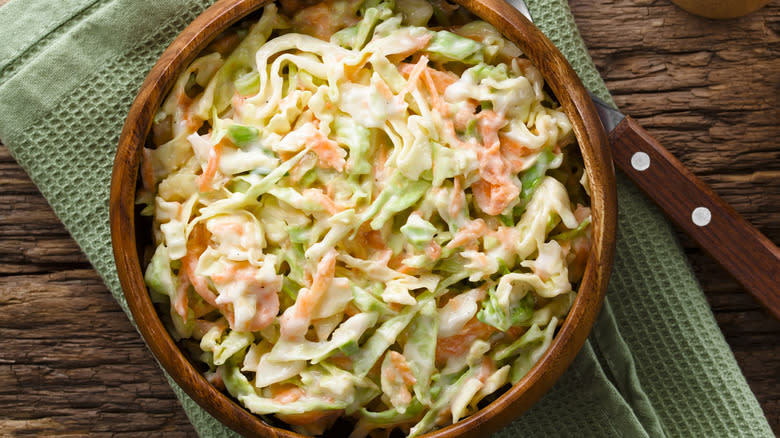
Coleslaw is a salad that virtually everyone loves. This simple yet delicious combination of shredded vegetables and dressing has been around in various forms since the Roman period but found its footing when its modern form was perfected in the Netherlands. Dutch koolsla, which translates to "cabbage salad," forms the basis of the coleslaw that we know and love today, and when the recipe made its way to the United States, it quickly gained a foothold as the perfect accompaniment to barbecued meats.
The beauty of coleslaw, whether you see it as a salad or condiment, is how versatile it is. While it's traditionally made with a combination of thinly sliced cabbage, carrots, and onions, with a mayonnaise-based dressing tying it all together, it lends itself to a mammoth variety of tweaks and recipe changes. As coleslaw has developed in communities around America (and around the world), local influences have resulted in dozens of coleslaws specially designed to complement the unique tastes of the folks who championed them. We made it our mission to find as many different coleslaw types as we could, so you could try something new, and maybe even find your new favorite recipe.
Read more: 12 Vegetables And Fruits That Used To Look Very Different
Classic Creamy Coleslaw Is Made With Mayo
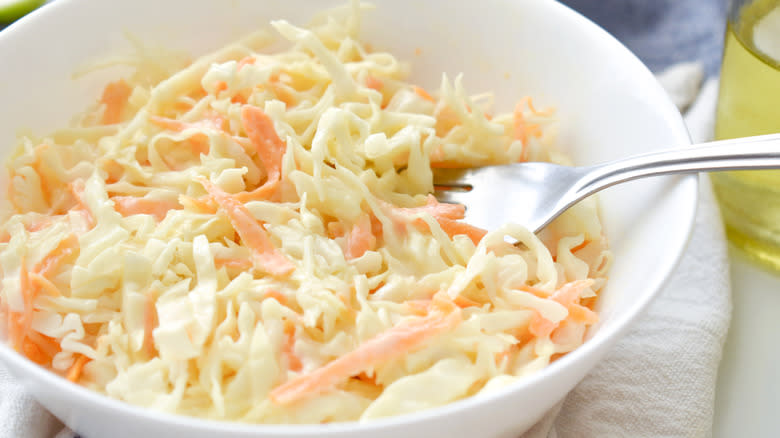
When most people think of coleslaw, they think of shredded cabbage held together by a creamy dressing. More often than not, that creamy coleslaw dressing is based on mayonnaise. This wasn't always the case: Some of the earliest recipes for coleslaw, like the 1770 recipe published in the Dutch cookbook "The Sensible Cook: Dutch Foodways in the Old and New World," used a vinegar-based dressing spiked with butter and oil. Mayonnaise was also invented in the 18th century, first became popular in France, and soon made its way over to America. Soon, enterprising chefs began to combine the two, making coleslaw with mayonnaise and creating a food sensation.
Mayonnaise works perfectly in coleslaw, as it has a perfect balance of creaminess and tanginess, providing bulk and a smooth texture without being too cloying. It also acts as a versatile base upon which you can build an almost endless amount of flavors. While some coleslaw dressings are made solely from mayonnaise, others have other creamy elements added in, like sour cream or Greek yogurt. Both of these ingredients help to reinforce its smoothness while adding a touch of extra acidity.
Lexington Red Slaw Uses Ketchup
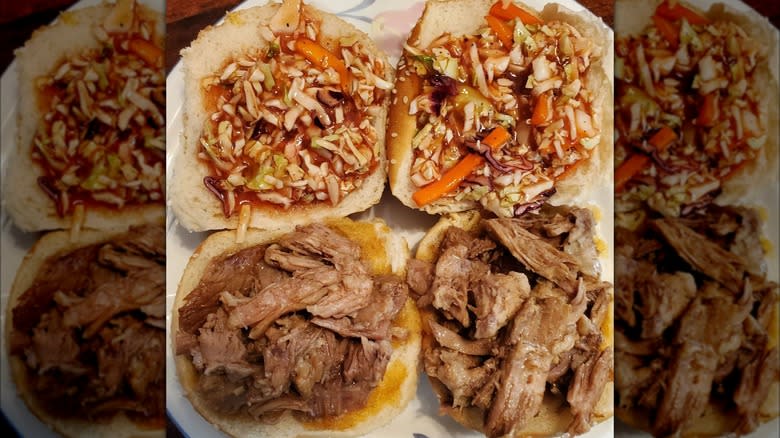
In Lexington, North Carolina, they make their slaw a little differently. Lexington red slaw, also known as barbecue slaw, is a local specialty and may even be the only coleslaw option in certain BBQ joints around town. The coleslaw gets its name from the ketchup that serves as the base of the recipe instead of mayonnaise. This ketchup is then bolstered by extra vinegar and sugar, to give the green cabbage a tangy, sharp taste that matches its bright tones, and sometimes a dash or two of hot sauce to add smokiness and heat.
Lexington red slaw is a classic accompaniment to barbecued meats. While its key ingredients tend not to waver, the ratios are often tweaked to match each chef's taste. "The taste of it here in Lexington with the barbecue places we have in town is all over the map. Some are fairly sour. Mine is fairly sweet. It just depends on how much ketchup and sugar you put in and it goes all over the place," restaurant owner Mike Swing tells The Fayetteville Observer.
German Krautsalat Uses Caraway Seeds
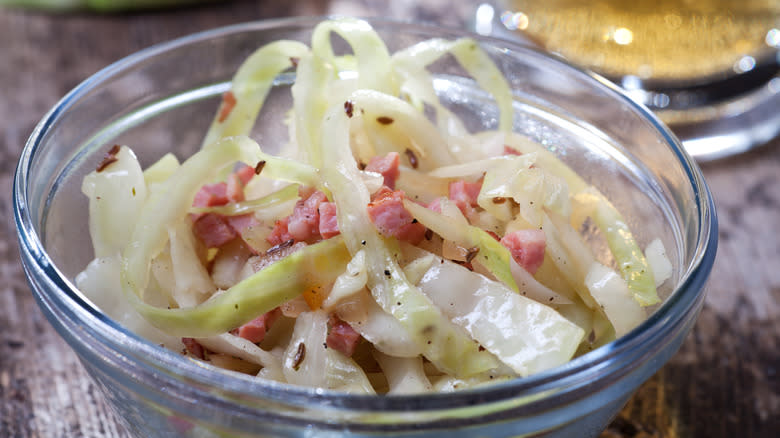
As the modern version of coleslaw originates in the Netherlands, it's little surprise that it spread to its neighboring countries, where subsequent versions of the recipe were then developed. In Germany, krautsalat is the result. This coleslaw does away with the need for mayonnaise and instead dresses raw green cabbage and cooked onions in a sprightly mixture of oil, sugar, vinegar, and salt. As a result, it has a lighter, sharper taste, almost like a young or undeveloped sauerkraut.
The real distinguishing factor with krautsalat, though, is caraway seeds. The seeds are cooked with the onion to help them release their pungent, anise-laced flavor and scent before the mixture is stirred in with the cabbage and dressing. The caraway flavor gives the whole dish a slightly woody dimension that stops the vinegariness from becoming overpowering. Like sauerkraut, krautsalat is commonly served as an accompaniment to cooked pork or sausages, or alongside a portion of dumplings. It's possible to make it without cooking the caraway seeds and onion first, but bear in mind that this produces a different flavor, with more sharpness from the raw onion and less depth from the seeds. If you don't have caraway seeds, an easy spice substitute can be cumin seeds to make this coleslaw -- just bear in mind that this will give it less of an aniseed flavor and more of an earthy taste.
Marinated Slaw Soaks Its Cabbage In Vinegar
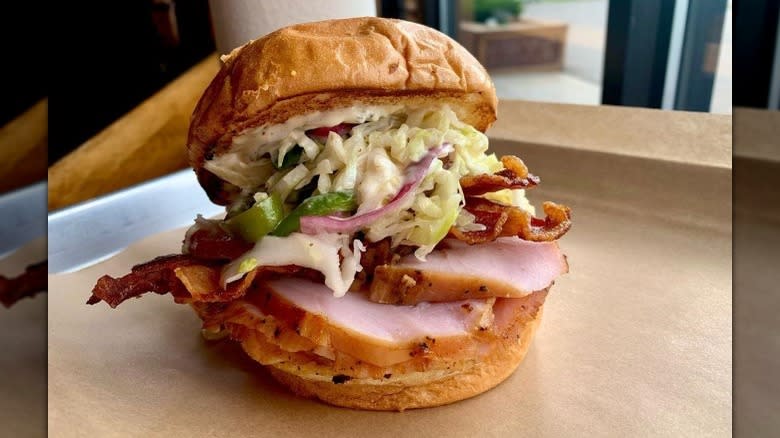
Coleslaw generally needs a little time for its flavors to develop, and allowing the cabbage to sit in its dressing ensures that all of the dish's ingredients are well incorporated. Marinated slaw, though, takes things to the next level. Marinated slaw is popular in North Carolina and, like the barbecue it's served with, takes the slow approach. To prepare it, chefs shred cabbage and other ingredients and then soak them in a mixture of apple cider vinegar and sugar, which has been brought to a boil and allowed to cool.
A day or two later, the slaw is ready. "What you're left with is a very delicious, sweet type of slaw. It's absolutely delicious," says Charlie Bourque, manager of Moe's Original BBQ in Asheville, to The Fayetteville Observer. The vinegar and sugar provide a hit of sweetness and a serious acidity that gets deep into the naturally sharp bell peppers and raw onion, and which helps to balance out any smoky barbecue flavors it's served alongside. Because this coleslaw doesn't contain mayonnaise, it can be a little looser and, naturally, lacking in creamy notes. What you lose in creaminess, though, you make up for in deep, developed flavor.
Classic Southern Coleslaw Uses Buttermilk
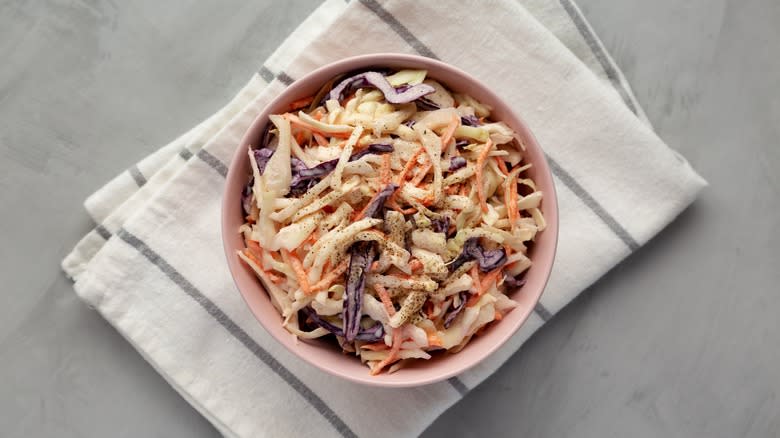
Coleslaw often shows up as an accompaniment to a host of classic Southern recipes, particularly those where BBQ flavors reign supreme. Although certain coleslaw recipes in Southern states omit mayonnaise or other creamy ingredients, white coleslaw is still by far the most common style across the board.
What makes a mayonnaise-based coleslaw distinctly Southern, though, is the inclusion of buttermilk. Buttermilk's popularity in Southern cooking is partly due to its longer shelf life, which traditionally made it easier to store and use in warmer climates where normal milk would go bad without refrigeration. This butter by-product has a slightly sour flavor that gives coleslaw an entirely new dimension which makes it more compatible with other classic recipes like buttermilk fried chicken or cornbread.
As buttermilk is a liquid, it's usually paired with a thicker element to help the coleslaw bind together, and mayonnaise is the traditional choice (although you can also use sour cream). It's important to use enough sugar, too, to balance out the sourness of the buttermilk, while simultaneously bolstering it with spritzes of lemon juice and vinegar.
Memphis-Style Coleslaw Has Green Bell Peppers
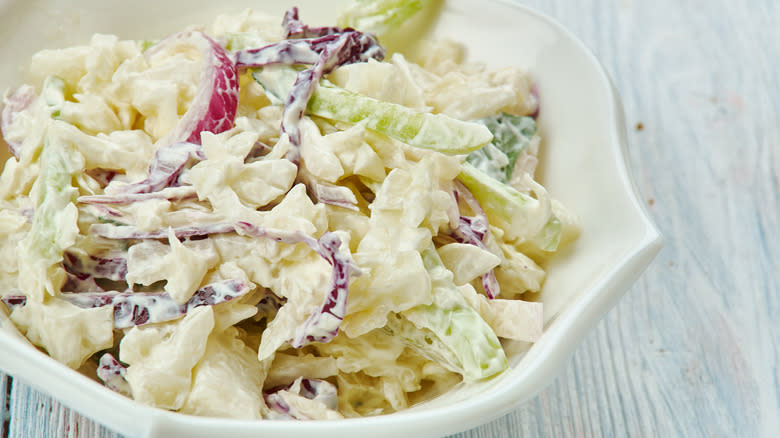
The predominant ingredient in coleslaw is cabbage, but it's the kind of salad that you can throw any crispy produce into and have it work. In Memphis, green bell peppers are a key element. A classic ingredient in coleslaw recipes in BBQ joints like Corky's, green bell peppers are uniquely suited to growing during the long, humid Tennessee summers. It only makes sense, therefore, that they eventually made their way into the salad, where their flavor provides a sharp contrast to the relatively mild-tasting cabbage.
The difference between green, yellow, and red bell peppers might not be immediately clear, but once you consider their tastes, it makes sense as to why the former is used in coleslaws. Green bell peppers are essentially the unripe version of the fruit and have a crisp, earthy flavor. Yellow and red bell peppers, meanwhile, are slightly sweeter, with this flavor element increasing the more they age. Green bell peppers also usually have slightly firmer flesh, which helps them hold their own in coleslaw dressings. Memphis-style coleslaw uses a mayonnaise-based dressing, and the addition of Dijon-style mustard pairs well with the green peppers, with its warmth underlining the peppers' earthiness.
Mustard Slaw Contains, You Guessed It, Mustard
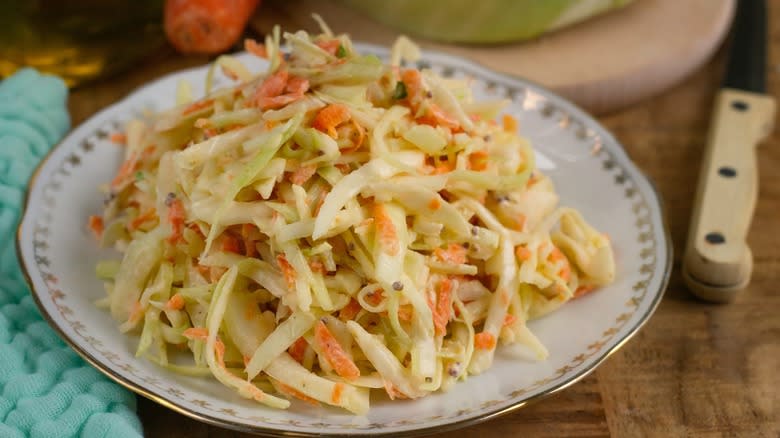
A coleslaw's dressing plays a massive role in its flavor, and certain recipes like to go bold with their base ingredients. This is the case in certain parts of South Carolina, where mustard slaw is the go-to option. This slaw uses one or several types of mustard to bring everything together, with Dijon, yellow, or dry mustard being the most commonly used. This mustard is then stirred into a mixture of vegetable oil, sugar, celery seeds, and vinegar, with the dressing cooked before it's stirred through a combo of cabbage, carrot, and sometimes onions and bell peppers.
Cooking the dressing before adding it to the vegetables helps to activate the flavors of both the mustard and the celery seeds, which gives this coleslaw a deep fragrance and exciting, complex flavor. Mixing your mustards in this recipe, too, can be a great way to unlock different dimensions and excite your palate from all angles. The mustard used gives the coleslaw a spiciness and heat that slightly takes away from its ability to neutralize the fiery taste of barbecue, as regular, mayonnaise-based coleslaw does. In its place, though, is a punchy flavor that holds its own at any cookout, and which is as good in sandwiches as it is on the side of a plate.
Hawaiian Coleslaw Is Packed With Pineapple
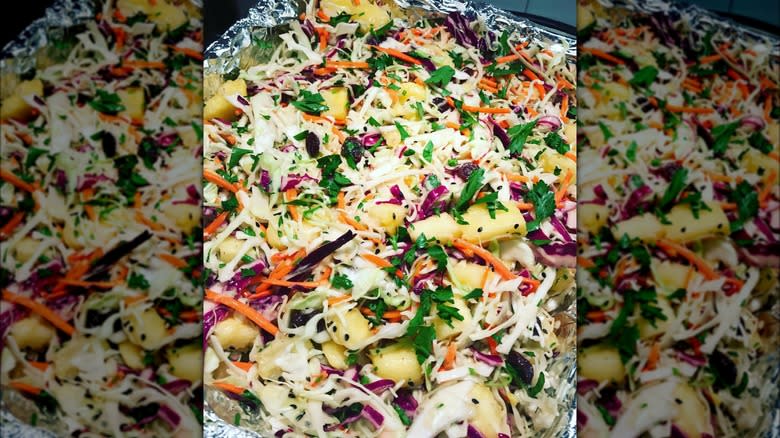
Coleslaw is most successful when it has a balance of sweetness and tanginess, and in Hawaiian coleslaw, the former is provided by pineapple. The Aloha State grows pretty much all of the pineapples that are sold by the U.S., and the fruit makes its way into a lot of the islands' most iconic dishes, like Hawaiian fried rice. For coleslaw, pineapple provides all of its tangy sweet flavor and crisp crunchiness.
Because pineapple is quite sharp and has a bright, sugary flavor, Hawaiian-style coleslaw usually uses brown sugar in its mayonnaise-based dressing. Using brown sugar deepens the sweet flavors and provides a hint of caramel that helps to temper the fruitiness of the pineapple. Hawaiian coleslaw also has another source of sweetness through the inclusion of carrot, which gives it some subtly sugary notes. As a result, if you're making Hawaiian-style coleslaw, it's important to taste as you go, as it's easy for things to get way too sweet. Luckily, the cilantro also present in the recipe helps to balance things out, giving the dish an herbal, somewhat spicy note.
Alabama Hot Slaw Has Hot Sauce
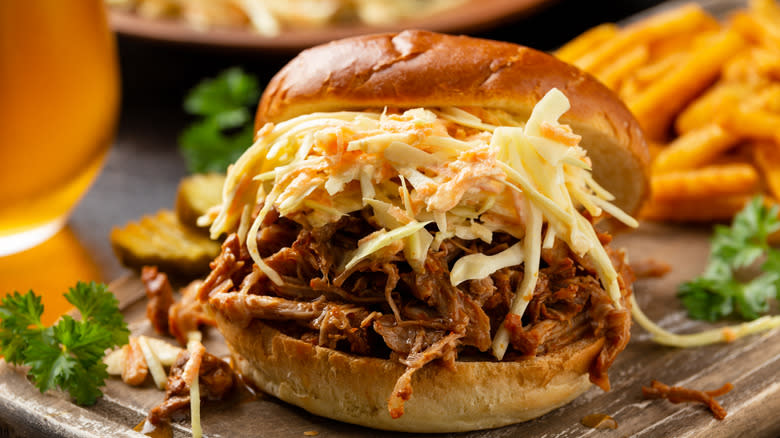
Coleslaw serves as an ideal counterpoint to bold barbecue flavors and as sort of a palate-cleanser between bites of spicy, perfectly smoked meat. In some parts of the country, though, they like to get those flavors into the coleslaw itself. Hot slaw is common in parts of Alabama and is made with hot sauce. Hot slaw recipes developed in the area throughout the mid-20th century, with restaurants like Bunyan's Bar-B-Q becoming famous for their spiked slaw.
Hot slaw is often made with Tabasco, which adds acidity and pepperiness to the salad, but it can be made with pretty much any hot sauce that people have at hand. The hot sauce is added not to a mayonnaise-based dressing but to a yellow mustard-based one, which is then seasoned with vinegar and brown sugar. Using mustard instead of mayo adds even more gentle spiciness (although if you're making this coleslaw at home, you should probably check how spicy your mustard is first, so you don't make something that's inedible). Importantly, too, hot slaw isn't just an Alabama tradition: Tennessee-based brand Fuzz's Hot Slaw is an essential part of many people's weekly shopping lists and seriously brings the heat.
Lebanese Slaw Is Full Of Herbs
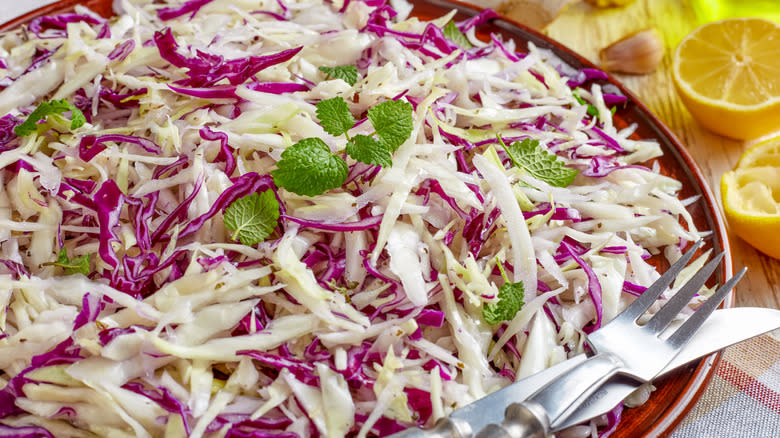
While coleslaw has European origins and is generally more commonly seen in Western food cultures, it's cropped up in various forms around the entire world. One good example of this is Lebanese slaw. Known as salatet malfouf, this verdant salad starts in a pretty familiar manner, with a generous helping of shredded cabbage. Instead of using white or red onions, though, sliced scallions are then added, as well as an abundance of fresh chopped mint, dill, and parsley. The slaw's flavor is amped up even more with a hit of fresh garlic and a sprinkling of za'atar, and it's all brought together by olive oil and lemon juice.
The result of this is a super-sprightly salad that tastes incredibly fresh. The combination of herbs not only boosts its visual appearance but makes it fragrant and complex. The za'atar, on the other hand, deepens the flavor, adding earthy and citrusy notes. Just as barbecue-style coleslaw is a great accompaniment to slow-cooked meat, salatet malfouf is the ideal side dish to chicken shawarma or meatballs and is also excellent tucked into a falafel wrap.
New York Deli-Style Slaw Is Spiked With White Pepper
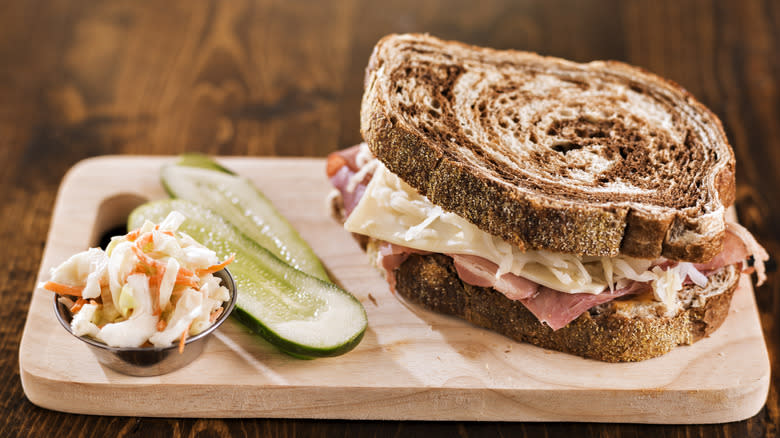
No trip to a New York deli is complete without grabbing a tub of coleslaw. Deli-style slaw offers a fresh, crunchy contrast to the salty intensity of deli meat and pastrami sandwiches. Arguably no deli does it better or produces coleslaw more iconic than Manhattan's Second Avenue Deli. First opening in 1954, the deli served a slaw that kept the population of the Lower East Side satisfied until its move to East 33rd Street in 2007.
So what makes deli-style coleslaw so special? It's in the subtlety of its flavorings, including white pepper and chives. Immortalized in "The Second Avenue Deli Cookbook," the quintessential deli coleslaw recipe gains its heat from the white pepper, which delivers a slightly less intense spice than its black counterpart. Balanced against the white pepper are the flavors of chives. While white and red onion give coleslaw a slightly acrid punch, chives are milder and create a garlicky flavor note and scent that rounds out Second Avenue Deli's slaw nicely. Everything in the coleslaw is held together by mayonnaise, which also smooths out the flavor additions.
In Italy, Insalata Irlandese Is Made With Spring Onions
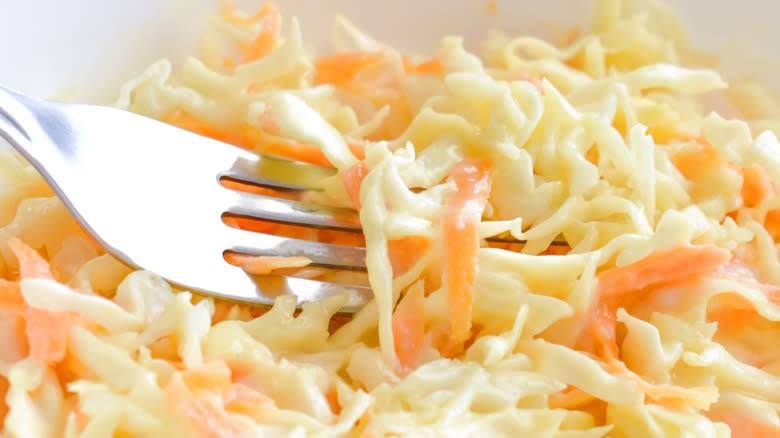
Coleslaw generally isn't associated with Mediterranean climates, but as the salad hits the spot on a hot summer's day, we can see why it's shown up in hotter parts of Europe. In Italy, though, it's called something else entirely. The Italian version of coleslaw is known as insalata irlandese, or "Irish salad." True to its name, its recipe sticks to the Irish coleslaw style, which is a fairly standard mix of mayonnaise, carrot, and cabbage.
Where insalata irlandese differs from Irish slaw, however, is in its inclusion of low-fat yogurt. Yogurt gives this coleslaw a gentle hint of acidity, which is bolstered by the sprinkling of white wine vinegar added to its dressing. Additionally, in place of white or red onions, it uses a combination of spring onions and chives, giving it a more gentle oniony flavor that still rounds out the profile of the dish. The dressing is given more punchiness by a dollop of mustard and a scrunch of black pepper, with a sprinkling of sugar finishing everything off.
Jicama Slaw Puts The Root Vegetable To Use
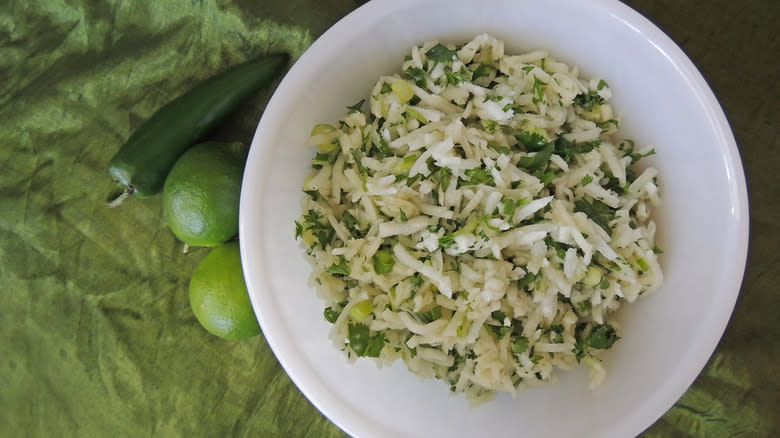
Think coleslaw, and you think cabbage. The core vegetable used in this salad isn't likely to change any time soon -- but now and again, it's fun to mix things up with new additions. Enter jicama slaw, a coleslaw that uses the Mexican and Central American jicama root to bolster the cabbage content.
Jicama's crisp texture and distinctive flavor (kind of like an apple, but less sweet) pairs perfectly with the cabbage and gives the slaw a serious freshness. Because jicama can be eaten raw, there aren't even any additional steps you need to do: You just julienne it, as you would your carrots in a regular slaw, and throw it in. Jicama slaw also frequently contains sliced radishes, which give it a pepperiness and add to its crunch, and freshly chopped mint.
Where this slaw pops, too, is in its super-fresh dressing. Instead of weighing the cabbage, jicama, and radish down with heavy mayonnaise, jicama slaw uses a combination of orange and lime juice, olive oil, and, if desired, a glug or two of honey or maple syrup. It all makes the slaw zesty, sweet, and deliciously sprightly.
Read the original article on Daily Meal.

